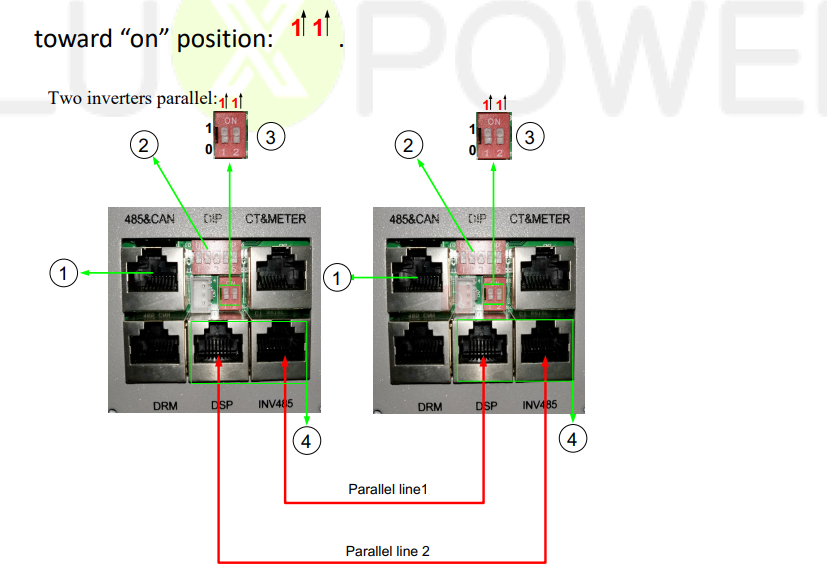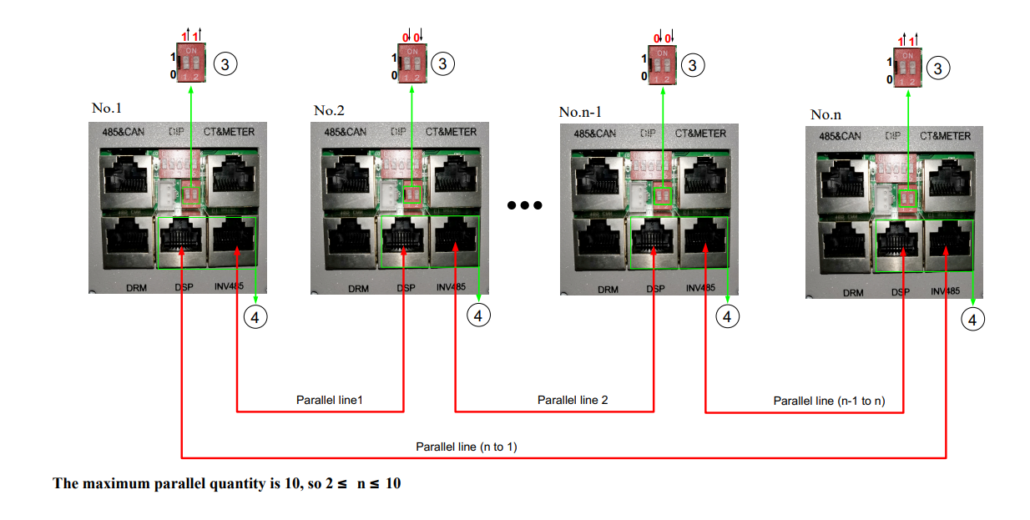If the inverter is purchased, our next step will be to relate how to install it. The main thing in the whole installation process is the connection between the solar panel and the inverter. So if you don’t want to use the manufacturer to install it for you. Or if you need to connect the solar panels to the inverter for some specific reason. Then this article may give you some help.
Types of solar panel connection inverters
Before creating the circuit, you must determine the right type of connection for your solar system. There are two general types of connection. Positive Sun can greatly extend the life of the line. At the same time, we need to purchase cables specific to the solar system. Also, use a solar-specific arrangement.
- Single Phase Parallel System Wiring
- Three Phase System Wiring
- Battery Connection in Parallel System
Tandem inverters with solar panels

Connecting panels in series increase the voltage of the system. This is due to the fact that the inverter requires a specific voltage from the solar system in order to function properly. So, in order to raise the solar panels’ voltage, we will employ a series connection. However, you cannot connect too many in series, as exceeding the maximum capacity of the inverter will affect its service life.
Connecting solar panels and inverters parallel

Connecting the inverter and solar panels in parallel causes the current to increase and the voltage to remain the same. The positive terminals of the solar panels are connected, as are the negative terminals of the two panels when they are connected in parallel. The parallel connection allows more solar panels to be connected and more electricity to be produced.
Solar panels connected in series compared to parallel
Parallel and series-connected solar panels are not the only options. However, we have found after various investigations that parallel and series-connected panels are the two most common ways of connecting solar systems.
The maximum total output voltage and current of the solar array must be considered in order to set up series and parallel connections. Solar panels and series-connected circuits have a similar operation. A fault with one of the series-connected panels will cause the circuit as a whole to malfunction. At the same time, a problem with one solar panel or a loose wire in a parallel circuit does not affect the other solar panels. So the type of inverter and how it is wired affects the efficiency of the series-parallel solar panels.
Which wiring works better - series or parallel?
Parallel wiring is preferable for our house inverters. This is so that individual panels won’t have an impact. The remaining panels will continue to function normally even if one of them malfunctions. Of course, there are now also hybrid inverters that support a mix of series and parallel connections. So series or parallel connection is not the only criterion for our choice of an inverter.
How to connect solar panels in series to an inverter
Series wiring is typically used for grid-connected inverters or charge controllers that require 24 volts.

The positive and negative terminals on solar panels are similar to those on batteries. The positive terminal of one panel is connected to the negative terminal of the second panel to create a series connection. In this manner, at least two solar panels can be connected to create a photovoltaic source circuit.
Positive and negative terminals on tandem solar panels?
String inverters need solar panels to function and have a rated voltage window. Additionally, it possesses the rated current required for the inverter to function effectively. String inverters have a maximum power point tracker (MMPT), which varies the current and voltage to produce as much power as possible.
Together, solar panel wiring and connectors facilitate the task. And tandem solar panels make an ideal choice for outdoor environments. If you’re an installer, the module you’re using was probably made to use this connector to attach to the junction box on the back of the panel.
The junction box will contain two wires.
- The female MC4 connector does usually connect to the solar DC wiring using one wire, the DC positive (+).
- The other is DC negative (-): this usually uses for the male connector
The advantage of wiring in series is that power can easily be transmitted over long distances. Disadvantage: If only one panel is covered or covered by leaves or other debris, it can affect the whole string.
How to parallel connect solar panels to an inverter
The positive terminal of the solar panel is connected to the positive terminal, and the negative terminal is connected to the negative terminal. This makes it easier to connect the panels in series. This allows for a better connection of all panels together.

This is the opposite of series wiring. With parallel wiring, the currents add up while the voltages remain the same. Shaded or covered panels do not influence the rest of the string thanks to parallel wiring. Like series wiring, you can connect different solar panels in parallel. The issue is that your system needs to be set at the minimal voltage, despite the fact that the currents build up.
How to connect solar panels to an inverter
Solar panels and inverters for the home have become a necessity. Inverters allow for the operation of all household appliances for convenience during power outages.
For those who want 24-hour power, solar panels and investors play a crucial role. At some point, due to its quiet and pollution-free capabilities, an inverter is something that every home should have.
- Join the inverter and the solar panel.
- Connect the batteries to the inverter.
- Join the batteries and the inverter.
- Join the solar panel and inverter.
- Connect the battery to the solar panel.
How to install the solar panel and inverter yourself
First, connect the solar panel’s positive lead to the inverter’s positive terminal. Then, connect the solar panel’s negative lead to the inverter’s negative terminal.
We can divide the installation process into four different steps.
1. Solar panel installation.
Placing the solar panels firmly on the roof is not a simple operation. We may need professional help. We also need to find the most suitable location for the solar panels. Maximizing the collection of sunlight and converting it into solar energy.
2. Connect the charge controller.
Its main function is to ensure that the current is constant. This is because an unconstant current can be very damaging to the inverter. In order to ensure that the current obtained from the solar cells flows into the inverter at a constant rate, we need to install a charge controller between the solar panels and the inverter.
3. Connect the battery to the inverter.
Connect the battery’s positive (+) terminal to the inverter’s positive (+) terminal and the battery’s negative (-) terminal to the inverter’s negative (-) terminal. On the back of the inverter, you will see the position indicating the 12V DC input. The inverter needs to switch off for this process.
4. Connect the battery to charge the controller.
The charge controller has positive (+) and negative (-) terminals for the battery, as shown in step 3 (above). Relate the charge controller’s positive (+) terminal to the positive terminal of the battery and its negative (-) terminal to the negative terminal of the battery.

